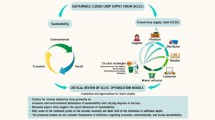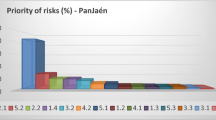Abstract
The paper considers a supply chain system in which the sole manufacturer supplies the same product to two retailers who compete in offering trade credit period to customers. Both the market demand and retail prices vary with the trade credit periods offered by the retailers. The manufacturer also provides a trade credit period to both the retailers to settle down their accounts. The net profit function of the supply chain is derived considering possible relationships among the trade credit periods offered by the manufacturer and the retailers and the time when each retailer receives the last payment from his customer. An algorithm is developed to find the optimal solution of the proposed model. From the numerical study, it is observed that a two-level trade credit financing can increase profits not only for the manufacturer and the retailers but also for the whole supply chain.







Similar content being viewed by others
References
Abad, P.L., Jaggi, C.K.: A joint approach for setting unit price and the length of the credit period for a seller when end demand is price sensitive. Int. J. Prod. Econ. 83, 115–122 (2003)
Bernstein, F., Federgruen, A.: Dynamic inventory and pricing models for competing retailers. Navel Res. Logist. 51(2), 258–274 (2004)
Cachon, G.P.: Stock wars: inventory competition in a two-echelon supply chain with multiple retailers. Oper. Res. 49, 658–674 (2001)
Chen, L.H., Kang, F.S.: Integrated inventory models considering the two-level trade credit policy and a price-negotiation scheme. Eur. J. Oper. Res. 205, 47–58 (2010a)
Chen, L.H., Kang, F.S.: Coordination between vendor and buyer considering trade credit and items of imperfect quality. Int. J. Prod. Econ. 123(1), 52–61 (2010b)
Chen, L.H., Kang, F.S.: Integrated vendor-buyer cooperative models with variant permissible delay in payments. Eur. J. Oper. Res. 183(2), 658–673 (2007)
Choi, S.: Price competition in a duopoly common retailer channel. J. Retail. 72(2), 117–134 (1996)
Dai, Y., Chao, X., Fang, S.C., Nuttle, H.L.W.: Pricing in revenue management for multiple firms competing for customers. Int. J. Prod. Econ. 98, 1–16 (2005)
Dave, U.: Letters and viewpoints on economic order quantity under conditions of permissible delay in payments. J. Oper. Res. Soc. 46, 1069–1070 (1985)
Dumrongsiri, A., Fan, M., Jain, A., Moinzadeh, K.: A supply chain model with direct and retail channels. Eur. J. Oper. Res. 187(3), 691–718 (2008)
Gilbert, S.M., Cvsa, V.: Strategic commitment to price to stimulate downstream innovation in a supply chain. Eur. J. Oper. Res. 150, 617–639 (2003)
Giri, B.C., Maiti, T.: Supply chain model with price- and trade credit-sensitive demand under two-level permissible delay in payments. Int. J. Syst. Sci. 44(5), 937–948 (2013)
Goyal, S.K.: Economic order quantity under conditions of permissible delay in payments. J. Oper. Res. Soc. 36, 335–338 (1985)
Goyal, S.K., Teng, J.T., Chang, C.T.: Optimal ordering policies when the supplier provides a progressive interest-payable scheme. Eur. J. Oper. Res. 179, 404–413 (2007)
Ho, C.H., Ouyang, L.Y., Su, C.H.: Optimal pricing, shipment and payment policy for an integrated supplier-buyer inventory model with two-part trade credit. Eur. J. Oper. Res. 187, 496–510 (2008)
Ho, C.H.: The optimal integrated inventory policy with price-and-credit-linked demand under two-level trade credit. Comput. Ind. Eng. 60, 117–126 (2011)
Huang, Y.F.: Optimal retailer’s ordering policies in the EOQ model under trade credit financing. J. Oper. Res. Soc. 54, 1011–1015 (2003)
Huang, Y.F.: An inventory model under two levels of trade credit and limited storage space derived without derivatives. Appl. Math. Model. 30, 418–436 (2006)
Huang, Y.F.: Optimal retailer’s replenishment decisions in the EPQ model under two levels of trade credit policy. Eur. J. Oper. Res. 176, 1577–1591 (2007)
Huang, Y.F., Hsu, K.H.: An EOQ model under retailer partial trade credit policy in supply chain. Int. J. Prod. Econ. 112, 655–664 (2008)
Huang, C.K., Tsai, D.M., Wu, J.C., Chung, K.J.: An integrated vendor-buyer inventory model with order-processing cost reduction and permissible delay in payments. Eur. J. Oper. Res. 202, 473–478 (2010)
Jaber, M.Y., Osman, I.H.: Coordinating a two-level supply chain with delay in payments and profit sharing. Comput. Ind. Eng. 50(4), 385–400 (2006)
Jaggi, C.K., Goyal, S.K., Goel, S.K.: Retailer’s optima replenishment decisions with credit-linked demand under permissible delay in payments. Eur. J. Oper. Res. 190, 130–135 (2008)
Khouja, M., Mehrez, A.: Optimal inventory policy under different supplier credit policies. J. Manufact. Syst. 15, 334–339 (1996)
Liao, J.J.: An EOQ model with non-instantaneous receipt and exponentially deteriorating items under two-level trade credit. Int. J. Prod. Econ. 113(2), 852–861 (2008)
Liao, J.J., Chung, K.J.: An EOQ model for deterioration items under trade credit policy in a supply chain system. J. Oper. Res. Soc. Jpn. 52, 46–57 (2009)
Moses, M., Seshadri, S.: Policy mechanisms for supply chain coordination. IIE Trans. 32, 245–262 (2000)
Ouyang, L.Y., Ho, C.H., Su, C.H.: Optimal strategy for an integrated system with variable production rate when the freight rate and trade credit are both linked to the order quantity. Int. J. Prod. Econ. 115, 151–162 (2008)
Sarmah, S.P., Acharya, D., Goyal, S.K.: Coordination and profit sharing between a manufacturer and a buyer with target profit under credit option. Eur. J. Oper. Res. 182(3), 1469–1478 (2007)
Sheen, G.J., Tsao, Y.C.: Channel coordination, trade credit an quantity discounts for freight cost. Trans. Res. Part E 43(2), 112–128 (2007)
Thangam, A., Uthayakumar, R.: Two-echelon trade credit financing for perishable in a supply chain when demand depends on both selling price and credit period. Comput. Ind. Eng. 57, 773–786 (2009)
Thangam, A., Uthayakumar, R.: Optimal pricing and lot-sizing policy for a two-warehouse supply chain system with perishable items under partial trade credit financing. Int. J. Oper. Res. 10, 133–161 (2010)
Teng, J.T.: On the economic order quantity under conditions of permissible delay in payments. J. Oper. Res. Soc. 53, 915–918 (2002)
Teng, J.T., Goyal, S.K.: Optimal ordering policies for a retailer in a supply chain with up-stream and down-stream trade credits. J. Oper. Res. Soc. 58, 1252–1255 (2007)
Teng, J.T., Chang, C.T.: Optimal manufacturer’s replenishment policies in the EPQ model under two levels of trade-credit policy. Eur. J. Oper. Res. 195, 358–363 (2009)
Teng, J.T.: Optimal ordering policies for a retailer who offers distinct trade credits to its good and bad credit customers. Int. J. Prod. Econ. 119, 415–423 (2009)
Trivedi, M.: Distribution channels: an extension of exclusive retailer ship. Manag. Sci. 44(7), 896–909 (1998)
Van Mieghem, J.A., Dada, M.: Price versus production postponement: capacity and competition. Manag. Sci. 45(12), 1631–1649 (1999)
Yao, D.Q., Liu, J.: Competitive pricing of mixed retail and e-tail distribution channels. Omega 33, 235–247 (2005)
Acknowledgments
The authors are thankful to the anonymous reviewers for their valuable comments and suggestions that helped in improving the quality of the paper. The first author gratefully acknowledges the financial support provided by the University Grants Commission, New Delhi, under UGC-DRS Program 2012–2016.
Author information
Authors and Affiliations
Corresponding author
Rights and permissions
About this article
Cite this article
Giri, B.C., Maiti, T. Trade credit competition between two retailers in a supply chain under credit-linked retail price and market demand. Optim Lett 8, 2065–2085 (2014). https://doi.org/10.1007/s11590-013-0702-x
Received:
Accepted:
Published:
Issue Date:
DOI: https://doi.org/10.1007/s11590-013-0702-x




